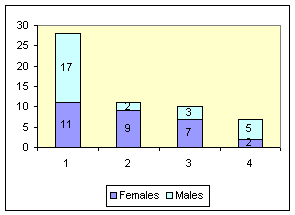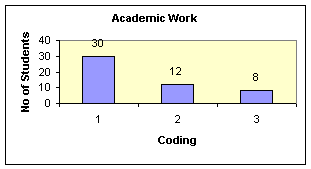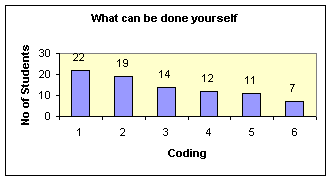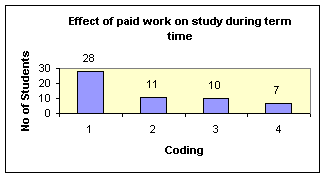How Business Students Learn
Mike Hart
Professor of Business and Informatics
King Alfred’s College
Winchester, UK
SO22 4NR
Phone: +44 (0)1962 827323
email: M.Hart@wkac.ac.uk
Paul Haslam
Head of Learning Technology
King Alfred’s College
Winchester, UK
SO22 4NR
Phone: +44 (0)1962 827450
email: P.Haslam@wkac.ac.uk
Abstract
Students now experience higher education in a rapidly changing environment. A sample of 50 second and third undergraduate students undertaking business courses was intensively interviewed to explore the ways in which elements of their life-space were combined. The majority of students were significantly engaged in part-time employment, with female students more likely to be employed for more hours in the week but also exhibiting a more independent minded approach to their work.
Paper presented to:
1st Annual Learning and Teaching Conference
Bristol Business School
University of West of England
24th-25th
September, 2002
There is a wealth of academic literature on the processes of learning, including concepts such as learning styles (Honey & Mumford, 1992, Kolb, 1984) and cognitive styles (Entwistle, 1987; Marton & Säljö,1997, Sternberg,1997). As adult learners, students experiencing higher education are increasingly encouraged to draw upon a variety of experiences to inform their subject matter, particularly those deriving from employment experiences (Burns,1995). In particular, the concept of the reflective practitioner can be utilised to enable students to make sense and to learn from a variety of ‘real world situations’ and to reflect upon the nature of activities (Schon,1987; Moon,2002). Moreover, as Knowles (1990) has indicated, adult students can expect to have a high degree of influence on what they are to be educated for and how they are to be educated. For these reasons, teachers in higher education increasingly define their task as the organisers of the learning experiences of their students.
However, the very real questions of how students learn and how they divide up their life-space particularly in the light of recent developments in higher education, remain somewhat under-researched. Students now routinely encounter a rapidly changing curricula (key or transferable skills), new modes of access and delivery (principally electronically communicated) and a very changed economic environment with the replacement of grants by loans. It was felt that a small scale survey, organised upon the lines of a pilot survey, and using an ethnographic approach would help to complement our own impressions as teachers in regular contact with their students with more systemically derived data. It is intended to utilise the results of the investigation to design curricula that more readily takes account of the changing patterns and experiences of student life in a much expanded higher education system. The approach to be followed derives more from interactionist theory than it does from conventional approaches to learning largely derived from a psychological literature base.
The design of the study
A sample was selected of some 50 undergraduate full-time students from the second and third year students studying Business in a college of higher education in the South of England. A multistage sample was deployed to ensure the group was representative of course and gender, with a random sampling method deployed within these categories. Although not designed to be a statistically representative study, care was exercised to ensure that the students selected for study were randomly selected (i.e. not volunteers) and that approximately equal numbers of males and females were selected (not necessarily representative of the student population from which they were drawn but broadly representative of the whole of higher education). Students were also drawn from a variety of degree programs in which Business was studied as a Single Honours programme, in combination with another subject in a Combined Honours programme or in a degree programme designed as a specialist ‘top up’ programme for entrants with an HND or an HNC. The sample design ensured that a sufficiently large number of mature students were included within the sample for some meaningful comparisons to be drawn.
The students were interviewed for approximately an hour with a free-ranging series of prompts, designed to elicit information under a series of headings. The areas for discussion emerged from three extensive pilot interviews. The interviewer had previously undertaken one of the Business studies courses offered by the college as a mature student and hence knew the student world ‘from the inside’ whilst at the same time having a degree of expertise in counselling and interview skills that fitted her ideally for the role. Each student identified as being part of the quota and then invited to take part in the study did contribute. As the sample constituted approximately one third of the total population of students undertaking business at the college, the data derived is felt to be representative of those students taking business studies (in various combinations) in the whole college. Interviewing took in October and November, 2001 (Autumn term).
Students were invited to speak freely on a series of topics:
· Use of various resources (Books, Computer, TV and video etc.)
· How do you feel that you learn best?
· Work related activities and their impact upon study
· Is there anything the college can do to aid learning?
· What do you think you yourself can do to aid your learning activities?
In order to increase student rapport, the information was recorded manually (rather than by tape-recorder). The data was coded and written into a simple flatfile table (in Word). Graphs were drawn by Excel whilst statistical analysis was performed using MICROSTATS and TURBOSTATS (statistical analysis programme written by one of the authors).
Statistical profile
In this profile, data is presented in the forms of tables and cross-tabulations. However, it is important to stress that this was not intended to be a quantitative study – the data is tabulated in order to give an impression of the generality of some of the features of the data but the whole thrust of the investigation was essentially ethnographic rather than statistical.
The sample
Crosstabulation of GENDER Gender of Respondent
By COURSE Course of Study
COURSE >│CHP Yr CHP Yr BusMgt BusMgt Bus │ROW
│ 2 3 Yr 2 t Yr 3 Admin │TOTAL
GENDER │ 1 2 3 4 5 │
├──────┬──────┬──────┬──────┬──────┤
Female 1│ 5 │ 3 │ 8 │ 4 │ 6 │ 26
├──────┼──────┼──────┼──────┼──────┤
Male 2│ 6 │ 3 │ 5 │ 6 │ 4 │ 24
└──────┴──────┴──────┴──────┴──────┘
TOTAL 11 6 13 10 10 50
22.0% 12.0% 26.0% 20.0% 20.0% 100.0%
Valid cases = 50 Missing = 0
Time per week spent on various activities
|
Hours per week |
|
|
Hours spent in class |
10.4 |
|
Hours spent travelling (weekdays) |
5.7 |
|
Hours spent reading |
7.9 |
|
Hours spent on the Internet |
5.5 |
|
Hours spent preparing |
9.9 |
|
Hours spent writing |
4.7 |
|
Total academic work |
38.4 |
|
Family/domestic commitments |
12.0 |
|
TV, Video |
7.0 |
|
Sport |
3.0 |
|
Entertainment, socialising |
4.0 |
|
Hours in employment (weekend) |
5.3 |
|
Academic work (weekend) |
3.1 |
|
Sleep (hours per night) |
( 7.1 per night) |
Work patterns
|
|
Numbers |
Percentages |
Cumulative Percentages |
|
Did not work |
19 |
38 |
38 |
|
1-9 hours |
4 |
8 |
46 |
|
10-19 hours |
18 |
36 |
82 |
|
20-29 hours |
5 |
10 |
92 |
|
30+ hours |
4 |
8 |
100 |
Commentary
It can be seen immediately that:
62% of students (2nd and 3rd years) worked for some period of time
54% of students were employed for more than 10 hours per week
18% of students were employed for 20 hours a week or more.
Many third year students intimated in interviews that they had curtailed their employment in order to devote themselves more comprehensively to the final year studies.
The ‘did not work’ category included students who were not interested for whatever reason in employment, who chose not to enter employment, or who in the case of joint Business/Sports Studies students devoted their spare time to sporting activities (which are to some extent course-related).
The data as a whole confirms the picture painted by national surveys of student employment patterns. In particular, the figure of 62% exactly mirrors the most comprehensive recent survey into student finances (Callender & Kemp, 2000: 117, Table 4.1)
Work patterns by gender
Crosstabulation of GENDER Gender of Respondent
By EMPLOY_C Coded hrs paid employment
EMPLOY_ >│ 1─ 9 10─19 20─29 30+ │ROW
│hours hours hours hours │TOTAL
GENDER │ 1 2 3 4 │
├──────┬──────┬──────┬──────┤
Female 1│ 3 │ 8 │ 5 │ 3 │ 19
[Row %] │ 15.8 │ 42.1 │ 26.3 │ 15.8 │61.3%
[Col %] │ 75.0 │ 44.4 │100.0 │ 75.0 │
[Chis ] │ 0.1 │ 0.8 │ 1.2 │ 0.1 │
├──────┼──────┼──────┼──────┤
Male 2│ 1 │ 10 │ 0 │ 1 │ 12
[Row %] │ 8.3 │ 83.3 │ 0.0 │ 8.3 │38.7%
[Col %] │ 25.0 │ 55.6 │ 0.0 │ 25.0 │
[Exp ] │ 1.5 │ 7.0 │ 1.9 │ 1.5 │
[Chis ] │ 0.2 │ 1.3 │ 1.9 │ 0.2 │
└──────┴──────┴──────┴──────┘
TOTAL 4 18 5 4 31
12.9% 58.1% 16.1% 12.9% 100.0%
Valid cases = 31 Missing = 19 Signif. level
Total chi─square D.F. Probability 5% 1% Cells with E.F. < 5
5.945 3 11.43% No No 6 of 8 ( 75.0% )
Hypothesis Test: Working Students by Gender
Expected frequencies are printed below observed frequencies:
│ 1-19 hours│ 20+ hours│ Totals
───────┼───────────┼───────────┼──────────
Females│ 11 │ 8 │ 19
│ 13.48 │ 5.52 │
───────┼───────────┼───────────┼──────────
Males │ 11 │ 1 │ 12
│ 8.52 │ 3.48 │
───────┼───────────┼───────────┼──────────
Totals │ 22 │ 9 │ 31
0.46 + 1.12 +
0.72 + 1.77 +
Total chi-square = 4.071 df = 1 p = 0.0436
NOTE : 1 cells less than 5
Commentary
Our data reveals a clear dichotomy in the gender distribution of work patterns. In particular, of the students in paid employment:
42% female students (8 out of 19) worked for at least 20 hours per week compared with 8% male( 1 out of 12) students.
Evidently, explanations must be suggestive rather than definitive in view of the small sample size. However, we could surmise the relevance of two factors:
- More opportunities for the employment of young women in the catering and tourist industries
- Many male undergraduates were engaged in sporting activities, some of them course related (in the case of the Combined Honours students)
Does employment impact upon academic work?
|
|
Percent |
Comments |
|
Good |
20 |
‘It is a two-way process and they complement each other, although there is some conflict with time management.’
‘I enjoy working – it is like socialising as so many KAC students work there. It stops my need for a social life’.
‘My time management is better as I have to plan in advance’ |
|
Bad |
50 |
‘It does make me tired and sometimes I find it hard to get to lectures. ..I have to sleep during the day to keep going’ |
|
No effect |
18 |
‘It doesn’t have any effect as the hours are very flexible’ |
|
Other |
12 |
‘I used to work in the past and it affected my social life. Students who want a good social life haven’t time to work as well’. |
Commentary
Female students seemed more likely to report beneficial effects (9:2) whereas males were more likely to report a bad effect (11:17). The data shows a mixed pattern in that 50% students report that employment had a deleterious effect upon their academic work with the remainder claiming that it had a beneficial, neutral or mixed effect.
Perceived effects of employment on academic study by gender
Learning Activities
|
|
|
|
|
|
|
Hypothesis test
Expected frequencies are printed below observed frequencies
│'Bad' │'Good' │'None' │'Mixed' │Totals
───────┼───────────┼───────────┼───────────┼───────────┼──────────
Females│ 11 │ 9 │ 7 │ 2 │ 29
│ 14.50 │ 5.70 │ 5.18 │ 3.63 │
───────┼───────────┼───────────┼───────────┼───────────┼──────────
Males │ 17 │ 2 │ 3 │ 5 │ 27
│ 13.50 │ 5.30 │ 4.82 │ 3.38 │
───────┼───────────┼───────────┼───────────┼───────────┼──────────
Totals │ 28 │ 11 │ 10 │ 7 │ 56
0.84 + 1.92 + 0.64 + 0.73 +
0.91 + 2.06 + 0.69 + 0.78 +
Total chisquare= 8.565 df = 3 p = 0.0357 NOTE :3 cells less than 5
Commentary
There is a statistically significant difference in the lower proportion of female students who report adverse affects of work compared with male students. Little (2002) reports on a DfEE study at the University of Northumbria in which two fifths of students felt that term time work adversely impacted upon their performance. However, the results from Hort and Rimmington (2000) survey showed that in a sample of eight UK universities (split between hospitality and non-hospitality courses), one half did not consider their performance had been damaged and a further quarter were undecided. The data collected here tends to support the findings from the Hort and Rimmington survey.
How students learn best
|

Commentary
The student sample appears quite traditional in many respects…
I like sitting down reading books and making notes.
I like to read something and understand it and then write it in my own words so that I remember it.
I learn best reading round the subject to get background. Assignments also help as you spend so much time researching they give you a good overview of the module by the end.
Writing helps you learn because I have to think about it more. I also like to read and make notes.
It is perhaps of some surprise that the Internet and the more ‘visual’ sources of information are regarded as of intermediate importance – whilst some are very favourably inclined, others are more cautious in their assessment.
I learn best from the Internet because the amount of information available. It is an easier resource to use and you can print off what you want. It is easier to organise.
I find the core textbooks are best for learning. I read them and then I can memorise them. If I am revising for an exam I like to read and read until I understand. Internet is not much good for learning.
Academic Work
|
Commentary
The predominant and preferred pattern is evidently one of sustained and regular work. Perhaps surprisingly, there is no evidence of a gender difference in the distribution of the responses.
What King Alfred’s could do?
|
Commentary
Highest on the student ‘wish-list’ was more frequent interactions with staff, perhaps unsurprising when resources in the whole of the sector are under increasing strain. The demand for extra facilities was particularly concentrated among the mature student population, some of whom had family responsibilities.
KAC is much better than my previous experience of higher education, where the classes were much larger and the tutors never available. You could spend weeks trying to find the Tutor.
Ensure Power Point is used in all lectures if possible and it gives the lectures more focus and is stimulating.
Student Services have always been very supportive. They helped me through a bad patch last year and this year I have been OK.
I would like more copies of books in the library; often the one you want or need isn’t there.
I would like practice assignments to see if standard and content are right, this is especially important for students who may have been out of studying for a long time.
I would like Mums within College self-help group during the College week perhaps just after lectures.
I would like KAC to offer more structured revision sessions for exams, as it is not always easy to arrange a one to one with the Tutors. Maybe there could be a chat room on the VLE where you could talk things over with other students or even the Tutor - especially the examinations.
What can be done yourself ?
|
Commentary
The observations under this category were many and varied. However, it was evident that two prominent and recurring themes was the felt need to be doing more reading around subject areas (and not just for assignments) and to time-manage multiple commitments/
Create more workspace at home
Do more reading not just for assignments – reading round the subject.
Plan my college work better
Improve grammar, English and essay writing.
Discipline myself more – it is too easy to go out rather than stay in and study
Keep up my motivation. If I do badly in my 1st assignment this will reflect on my overall degree result and I might lose motivation.
Effect of paid work on study during term time
|
Commentary
It is clear that half of the responses recorded the fact that paid work would have a deleterious effect upon study. But another way of looking at the data indicates that in half of the responses, there was felt to be either a good effect, a neutral effect or a mixed effect. In the case of Business disciplines, a certain amount of exposure to paid employment helps to embed certain of the themes found in the course (IT skills, working in groups, employee motivation and management). In the case of courses in which there not such an evident ‘spill-over’ of the course materials into the employment locale, the deleterious effects may be perceived even more markedly.
Any further investigations might serve to focus more explicitly upon those elements of the work experience that particularly benefited students, as well as serving to minimise the perceived bad effects.
It is worth noting that the pattern of responses indicating a ‘bad effect’ incorporates comments both from students who felt it was having a bad effect as well as students who felt that it would have a bad effect upon their academic work (as the first quote below indicates)
If I worked in term-time, I would be too tired to do my college work
If you work say over 10 hours a week it is too many and you have to rush your College work
Although it is hard work my work placement is course related and has proved an excellent stepping-stone and learning curve. Also I am allowed to do my College work when they are not too busy. The company has even offered me a managerial position.
It is a two way process and they each complement each other, although there is some conflict with Time Management
My work has no effect- I think that the knowledge I have gained from the course helps at work
I only work in the holidays because of my sport commitments; I don’t really have time in term time.
More detailed analysis of the 28 negative responses indicated the following pattern:
|
|
Categorisation of negative responses |
Number |
Percent |
|
|
Actually impeded academic work |
11 |
39% |
|
|
Generally negative comments (would impede family life, social ;life) |
7 |
25% |
|
|
Sentiment that it would impact upon academic work and social life if one had a job (or based upon past experiences of work) |
10 |
36% |
This pattern of responses shows that the
actual damage to student academic progress caused by the necessity to undertake
part-time employment might not be as severe as first thought.
Skills gained from
work
|
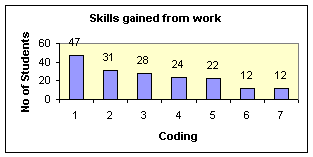
Commentary
It is perhaps significant that Interpersonal Skills tops this self report list of skills derived in the workplace. It might have been hypothesised that Time Management would have received a greater prominence than it did.
Interpersonal Skills…
Patience, initiative, management skills…
Cash handling, stock control…l
Customer Care…
Knowledge of Retail Trade…
Time Management…
Working in a Team…
A ‘thick’ description
Business students at King Alfred’s convey a picture of generally hard-working, committed and motivated students who manage to combine successfully the demands of the college curriculum, employment whether financially necessary or not and social life. These three activities often interpenetrated each other – some students reported that work was a source of social life for them whilst others argued that some employers allowed them time to study in employer’s time!
There did not appear to be major cleavages of the data by course although gender differences were more apparent in employment patterns, styles of learning and time management. Mature students felt that welfare facilities did not cater specifically for their needs (crèche etc.)
The gender differences apparent in the sample were illuminating.
It appeared that female
students were much more likely to:
[figures in brackets refer to ratio of female:male responses]
o Prefer working on their own [70%-30%]
o Use visual modes of communication (TV, video, Powerpoint) [71%-29%]
o Learn by reading/writing activities [61%-39%]
Whereas male students were somewhat more likely to
o Learn in groups [55%-45%]
o Learn in Group Activities [58%-42%]
The responses in which students were asked what they could do assist themselves as independent learners also showed a clear differentiation by gender:
o More reading and writing [66%-34%]
o Better Time Management [64%-36%]
o Improve skills e.g. in IT [75%-25%]
o Self discipline [65%-35%]
o Motivation [70%-30%]
At first glance, the data seems to disconfirm stereotypes (female students learn better by discussion and methods involving verbal communication). Closer examination of the data reveals that the female students were often more committed to independent study whereas male students felt the need for more explanations from tutors and a greater degree of ‘hand-holding than their female counterparts’. This finding may be an artefact of a college with a higher proportion than the average of female students (approx 2:1) in which an institutional and cultural norm has become internalised and may not be found to such a marked degree in other HEIs. Nonetheless and despite the small sample size the consistency of these responses tends to suggest an underlying value orientation in which female students are more conscientious, committed and organised than their male counterparts.
In the sample as a whole, groupwork tended to evoke quite strong reactions…but positive reactions outweighed negative by a factor of 2:1. In particular, groupwork unless carefully organised was perceived as penalising the diligent and well-organised whilst rewarding the indolent. (For this reason, the Business Management group at King Alfred’s have a carefully articulated rubric for Groupwork, designed to overcome some of these perceived problems)
(Positive)
I prefer to work in a
group as others people’s input can help – I
also like to know what others think
(Negative)
I have had some rotten
experiences of group work.. I hate group
work for assignments…I feel my grade is dependent upon others
who may not be putting in as much as other group members
Students appeared to be traditional in their methods of learning (books, note-taking) and whilst using VLE and internet-related material tended to see these essentially as resources rather than methods of tuition in their own right.
Comparison between the various types of courses did not reveal startling variations. The mature students were more inclined to be vocal in their call for facilities that would assist them cope with domestic and financial responsibilities as well as study. Consequently, they were less likely to be involved in paid employment during term-time (average of 7.0 hours per week for the 25+ cohort, compared with 10.7 for 19-24)
Pedagogic implications of the data
Surveys such may best be regarded as a pilot survey for more sophisticated analyses in subsequent surveys, as well as generating fruitful new areas of enquiry. Two themes in particular have been highlighted in this survey
Prevalence of part-time work
In a very real sense, it can now be said that the majority of students in the UK higher educational system are part-time students. As levels of indebtedness are set to increase, so the financial necessity to participate in the economy as part of a casualised labour force increases.
The survey data may well understate the true extent of employment as the design was limited to second and third year students and some of the latter had built up savings to obviate the necessity of working in a crucial final year. If one adds in first year undergraduate as well as postgraduate students, then the self-reported figures for employment may well be an underestimate.
Business departments should be in a position to capitalise on the work experience of their students. The experience of work provides a ready source of data and insights that can be brought into assignment work. The work experience may well form part of an additional qualification such as the Personal Development Awards offered by the City and Guilds of London Institute. Openings provided by part-time work may often lead to a credit-bearing work experience module provided by the HEI. Employers typically require evidence of knowledge, understanding and skills gained from some employment experience, whether formally certificated or not.
The prevalence of student employment now opens up the possibility of part-time employment providing both payment and socialisation opportunities. As one respondent observed:
I enjoy working- it is like socialising as so many KAC students also work there. It stops my need for a social life.
In many ways, the formal distinctions between academic word, paid work and social life become blurred with ‘semi-permeable membranes’ as each mutually influence the other.
The conventional mode of delivery of four modules per semester in the typical undergraduate programme allows delivery to take place in four afternoon or evening sessions which can be concentrated, in theory, into two days per week. It is now more possible to organise a period of academic work in which 2-3 days per week are freed of formal academic commitments allowing increased opportunities for paid employment. The increasing deployment of Virtual Learning Environments only increases possibilities in this respect.
Gender implications
It is now acknowledged that an ‘achievement gap’ is becoming increasingly apparent in the performance of male and female students becoming as wide as 9 percentage points in the A-C level passes at GCSE (Guardian, 2002). Some newspaper commentators have suggested that the movement towards modularised examinations incorporating coursework gives a relative advantage to girls. Evidently wider social patterns are involved and as Duff (2002) shows girls are more likely to read magazines and to read books for pleasure, in effect practising a skill that is helpful to schoolwork whilst boys are more likely to watch more TV and play computer games. Educators are now seriously addressing this issue at school level and, as Wragg (2002) argues, there is ‘no miracle solution, rather a series of linked moves throughout the age range’. It is worth making the point, though, as one female academic has pithily observed ‘It shows how sexist we still are that when girls do better, civilisation is at an end, but when boys do better it is taken as confirmation that they are secretly cleverer’ (Marshall quoted in National Literacy Trust,2002)
The data from this research is certainly consistent with these reported patterns as female students reported a style of more independent learning and there is some evidence that male students may require somewhat more support, either from tutors or in groups. The challenge for business educators is to construct curricula and modes of assessment that most fully tap the developing interests and abilities of students differentiated not only by gender but by socio-economic, cultural and ethnic differences. At the same time, it is increasingly articulated by students (and endorsed by their tutors) that curricula and assessment routines should reflect the dominant culture of the occupational groups to which they aspire. In this respect, mixed patterns of assessment regimes with combinations of formal examinations, reports, presentations, laboratory work and the like are less likely to show gender specific imbalances associated with the traditional formal modes of assessment.
Future Lines of Research
A promising field of further investigation suggested by this investigation is the exact nature of the interactions between part-time employment and the business studies curriculum. In particular, business educators need to indicate to students how even boring, repetitive, low status work (such as supermarket shelf-stacking) nonetheless contains the possibilities for ethnographic research into group interactions, leadership styles, organisational cultures and the like, reinforcing the point also made by McNair (2002). A training in some qualitative research methods is undoubtedly beneficial here to complement the more conventional quantitatively oriented techniques to which business students are typically exposed. As business educators, we also need to be aware of the resources that students can bring from their part-time employment into their academic resources. Students can then be encouraged to engage in an interplay of theoretical ideas and employment experiences by reflecting upon these in a more systematic fashion. In this way, they may also learn the truth of the dictum that there is ‘nothing so practical as a good theory’.
References
Burns, R. 1995. The adult learner at work. Sydney:Business and Professional Publishing
Callender, C. & Kemp, M. 2000. Changing Student Finances: Income, Expenditure and the Take-up of Student Loans Among Full- and Part-time Higher Education Students in 1998/99,London: Department for Education and Employment Research Report RR213,
Duff 2002. Girls vs Boys- the changing patterns of exam success, Childwise
http://www.childwise.co.uk/examsuccess.htm (accessed on 1/09/2002).
Entwistle,N. 1987. A model of the teaching-learning process in J. Richardson, M. Eysenck, & D. Warren Piper (eds) Student Learning: Research in Education and Cognitive Psychology, Milton Keynes: SRHE and Open University Press.
Guardian, The (Education Guardian) GCSE Results 2002, 31st August 2002
Honey, P. & Mumford, A. 1992. The Manual of Learning Styles.
(Available from Peter Honey, Ardingly House, 10 Linden Avenue, Maidenhead, Berks)
Hort, J. amd Rimmington, M. 2000. Results of a survey investigating part time and vacation work undertaken by higher education students with particular reference to the hospitality industry.. Appendix to HAVE report, DfEE.
Knowles, M.S. 1990. The adult learner: A Neglected Species. 4th edition.Houston: Gulf Publishing Company, Book Division.
Kolb, D.A. 1984. Experiential Learning: Experience as the Source of Learning and Development, Englewood Cliffs: Prentice Hall
Little, B. 2002. The Extent of Independent Work Experience and its Impact on Student Performance in P. Watton, J. Collings, J. Moon (Eds) Independent Work Experience: An Evolving Picture.. SEDA Paper 114, Birmingham: Staff and Educational Development Association (SEDA).
McNair, S. 2002. Learning and Working; the National Context in P. Watton, J. Collings, J. Moon (Eds) Independent Work Experience: An Evolving Picture.. SEDA Paper 114, Birmingham: Staff and Educational Development Association (SEDA).
Marton, F. & Säljö, R. 1997. Approaches to Learning in F.Marton, D. Hounsell & N.J.Entwistle (Eds), The Experience of Learning: Implications for Teaching and Studying in Higher Education, 2nd edition, Edinburgh: Scottish Academic Press.
Moon, S. 2002. The Academic Rationale for Reflection and Learning from Work Experience in P. Watton, J. Collings, J. Moon (Eds) Independent Work Experience: An Evolving Picture.. SEDA Paper 114, Birmingham: Staff and Educational Development Association (SEDA).
National Literacy Trust 2002. Press reports on gender in exam results and job market
National Literacy Trust.
Schon,D. 1987. Educating the Reflective Practitioner, Paper given to the American Educational Research Association.
Sternberg,R.J. 1997. Thinking Styles, Cambridge University Press: Cambridge
Wragg, T. 2002. Male might falls short. Times Educational Supplement: 30/08/2002.
